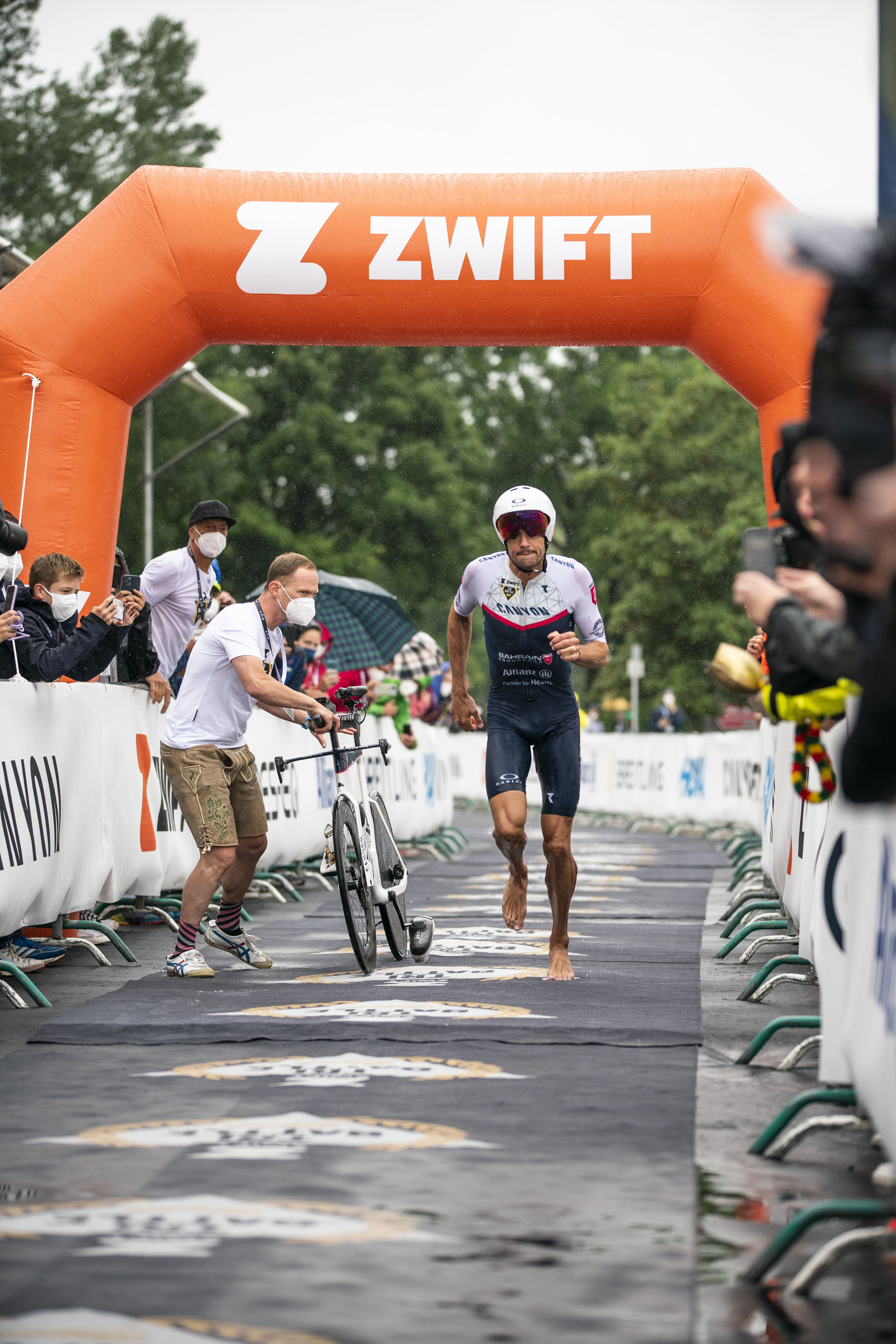Train like a Pro: How to maximise Zwift for tri gains
Turn on Zwift and just ride or run, right? Think again, with our pro-proven advice on structured training, fuelling, recovery and why you should think about embracing Beethoven

The gamification of indoor riding has revolutionised tri training, with the likes of Zwift supercharging the fun, competitiveness and productivity of turbo training for age-group triathletes. And all while erasing the boredom levels that came from staring at a basement wall trying to focus over the sound of the flywheel…
It’s not just age-groupers who have reaped the benefits, with superstar pro triathletes Lucy Charles-Barclay, Jan Frodeno and Alex Yee all regular visitors to Watopia, with the Zwift platform even hosting events – see the Super League Tri Arena Games – that blur the boundaries between the virtual and real worlds.
But how can you find a clear training focus for your indoor training sets? What’s the ideal indoor training setup? And what about comfort and recovery? Beyond Zwift’s ‘Fun is Fast’ ethos, there’s a wealth of data and customisable training options to maximise your riding and running gains. Let’s find out how you can provide structure to your training to make you a fitter, happier and more productive triathlete with winning advice from the elite orbit…
1. Take control of your training
“Zwift has had a huge impact on my training,” says British triathlete Lucy Charles-Barclay, the 2021 Ironman 70.3 world champion. “It gives me a way of training to a variety of intensities that can be planned in advance and aren’t open to outside factors, such as weather conditions, punctures and traffic.
“It’s also a really fun platform that still provides Strava segments, challenges and other people to ride with. The levels of consistency and intensity Zwift offers me have made great improvements in my training, and this seems to be affecting my race results very positively.”
Charles-Barclay is just one pro who uses Zwift for a deep dive into her data, with the post-workout analysis presenting athletes with power output readings, calories, duration and more.
2. Structure your sessions

“Zwift is a very effective way to build your fitness,” adds Jan Frodeno, Germany’s multiple Ironman world champion. “There are plenty of structured workouts and even programmes to guide you.”
These include the ‘Build Me Up’ bike power training plan, the TT Tune-Up to maximise your aerobic power, and the 5K Record Breaker on Zwift Run. “You’ll without a doubt be physically very well prepared, but make sure you don’t race every night!” the German tri superstar suggests.
3. Building your indoor setup
“Use whatever space you can find that’ll fit a turbo trainer or a fan,” says Rick Velati, a national coach with British Triathlon’s World Class Programme. “This can be living rooms, kitchens, garages, conservatories, but you’ll need to be online and a decent internet connection to hook into Zwift.
“If you want to be doing more heated sessions to prepare for hotter races, then a smaller room that heats easier than a bigger room is ideal or use a conservatory in which you can trap heat inside [as seen with Jonny Brownlee ahead of the Tokyo Olympics].”
4. Add an event focus
“Replicate race situations by setting the same bike and body positions for key efforts,” says Charles-Barclay. “Use the same data readings as you would in a race such as power (watts) and heart rate (HR), as this’ll help you replicate it on race day.
“Unlike being on the open roads, you can be very specific about planning your efforts and building interval sessions targeting improvements in your power outputs and consistency of delivery. This is sometimes very hard to do outside of this platform, especially through the winter, so make sure you maximise what you achieve from Zwift.”
The platform’s own workout library contains a vast array of workouts, but you can also create your own custom workouts or sync with Training Peaks or Today’s Plan and have your coach push workouts directly through to Zwift for you to enjoy.
5. Keep it varied

“I do anything from an hour to 3:30hrs on Zwift depending on the session,” says Frodeno, who won the Zwift Tri Battle Royale against Lionel Sanders in 2021. “VO2 Max intervals, for instance, are just much easier to ride on a turbo trainer, but my training is completely varied.”
Far from just showing up to race your mates around the Makuri Islands on Zwift (not that there’s anything wrong with that), there are 1,000+ structured workouts on the platform, as well as the chance to build your own custom workouts.
6. Vary your tunes
Music has long been shown to have positive impacts on training and racing, with Dr Costas Karageoghis stating in his book Inside Sports Psychology that high tempo beats can increase your endurance by up to 15%. And yet it doesn’t have to be just EDM or Idles providing the beats for your Zwift sets.
“Yes, dance music or rock is common, but some athletes actually go in the other direction,” offers Velati, a man who has worked with the cream of British tri for 16 years. “Some of our pros either use no music at all or, if they’re not wanting to affect any hormone or heart rate levels, they listen to classical musical that creates a deliberately calm environment. But for Zwift races or harder workouts, keep it individual or whatever gets you motivated.”
7. Feel the power
“The British Triathlon team have got a lot out of Zwift racing or connecting rides together,” states Velati, with the Brownlee brothers both converts to the platform. “Whether it’s on the turbo or rollers, you can control the zone you’re riding in or power output a lot compared to riding on the road. The classic workouts of FTP or 20min power zones all provide enough bang for buck.
“You can warm-up for 15mins and you then can get into the nuts and bolts of producing hard and controlled riding in your HR or power zones, as pretty much all of our team are using power now. Zwift offers a chance to go into a zone and work on that power, so 5-6mins in that zone and 2mins recovery. The team find that really motivating as they can individualise the workout that they’re doing.”
8. Electrolyte balance
The lack of airflow and often higher temperatures of indoor training will obviously change your level of sweat rates and nutritional needs. “What you lose in the electrolytes in your sweat can have a knock-on effect and subsequently a negative impact on your riding,” suggests Velati. So are there ways to gauge your altered electrolyte state?
“In terms of sweat rates, weighing yourself before you start and when you finish the workout can give you a really good guide on basic fluid loss. If you were sweating more, then some of the lessons the British Triathlon team take onboard is ensuring you have an electrolyte balance, while just drinking plenty of water ensures that your calcium levels are not getting depleted by riding indoors and sweating more over an hour or 90min session.”
9. Body conditioning

“The beauty of Zwift is that you can achieve every session you can imagine and make them very realistic,” states Charles-Barclay. “My sessions will range from short, power-focussed efforts – i.e. a 2 x 20min effort at power levels well above my Ironman power output.
“Other sessions will be four, five or even six-hour sessions more focused around conditioning of my body to hold an aero position and deliver consistent power outputs. If I’m focusing on a specific race then I’ll also try to replicate certain conditions. Before the Ironman Worlds in Kona, I do these sessions in a very hot environment, which can’t often be achieved on the roads in the UK.”
10. Indoor comfort
The nature and dynamics of indoor riding means that you’ll be spending more time in the saddle, increasing the likelihood of both sore bottoms and stiff backs. Yet there are simple measures that can boost your riding comfort and performance.
“Our team simply get out of the saddle every five minutes to break an hour or longer workout,” adds British Triathlon’s Velati. “Making sure your bib-shorts’ chamois pad goes well with your body and looking at chamois creams are also basics you should have in place. And, if you’re on the turbo for a longer period of time, then treat it like a road ride and have an energy bar or a snack to hand that you can eat every 20mins or so.”
Of course, riding indoors can lead to some particularly hot and sweaty sessions, so don’t underestimate the role that airflow plays in evaporative cooling. Unless you’re conditioning for warm weather events, at least one good fan is recommended.
11. Post-ride recovery
“Recovery wise, especially as you aren’t getting out of the saddle as much, make sure you’re spending five or six minutes stretching out the key areas of the lower back and hip flexors particularly,” suggests Velati.
“As you’re in a hunched position and not changing it as much, especially your movement in the lumber area, pay more attention to stretching and mobility work when you’re jumping off the turbo. There’s a real benefit to your own time management with indoor riding, but it’s worth knocking five minutes off a session to perform a proper recovery linked to both rehydration and mobility.”
12. Track your progress
“Zwift riding makes it easier to see the data for indoor riding with no random spikes due to sudden changes in gradient or traffic conditions,” believes Velati. “The data is more clinical to analyse and you can track progress. Most of our athletes all the way into the academies use Zwift with Training Peaks, which is a useful tool, especially as the athletes are riding using power.
“The thing I’d want age-group athletes to take away is you can get a lot out of indoor workouts by making it simple and achievable, with the intensity of the workout dictating what you get from it. So put some music on and take yourself out of your day-to-day work and focus on producing a bike workout in a safe and efficient way.”
Click here to try Zwift on a seven-day free trial today or sign up for just £12.99 per month.




